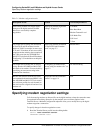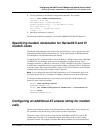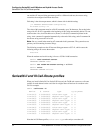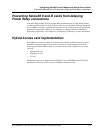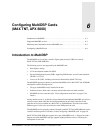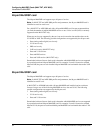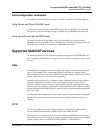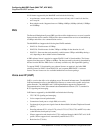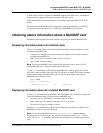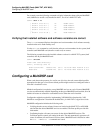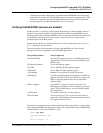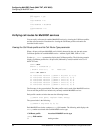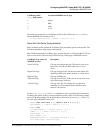
6-4 Preliminary May 9, 2000 APX 8000/MAX TNT/DSLTNT Physical Interface Configuration Guide
Configuring MultiDSP Cards (MAX TNT, APX 8000)
Supported MultiDSP services
V.110 features supported by the MultiDSP card include the following:
• Asynchronous, answer-mode only (answer, but no call out), with 1 start bit, 8 data bits,
and 1 stop bit.
• Rate-adaptive mode. Supported rates are 2400bps, 4800bps, 9600bps (default), 19200bps
and 38400bps.
PHS
The Personal Handyphone System (PHS) provides mobile telephone access to users located in
Japan and other Asian countries. PHS provides data communication services at bandwidths up
to 64Kbps and offers voice communication services.
The MultiDSP card supports the following data PIAFS standards:
• PIAFS 1.0: Fixed data rate of 32Kbps.
• PIAFS 2.0: Fixed data rate of either 32Kbps or 64Kbps for the duration of a call.
• PIAFS 2.1: Data rate that can dynamically switch between 32Kbps and 64Kbps during a
call, depending on the available wireless bandwidth.
A PHS software license is required to support PIAFS 1.0 and 2.0 functionalities. The license
supports fixed data rates of 32Kbps or 64Kbps. The data rate used by the unit is determined by
the rate from the PRI line.
PHS service is currently available only with Japan PRI signaling.
To support PIAFS 2.1 functionality, two software licenses are required—the initial PHS
software license for PIAFS 1.0 and PIAFS 2.0, and a separate PHS PIAFS 2.1 software
license. The two licenses are also available bundled into one license package.
Voice over IP (VoIP)
VoIP is a service that offers voice telephony across IP network infrastructures. The MultiDSP
VoIP implementation relies on the MultiVoice Gateway to connect calls to public and private
packet networks. The MulitDSP card’s VoIP implementation supports the International
Telecommunication Union Telecommunication Standardization Sector (ITU-T) standard for
H.323 signaling and messaging.
VoIP features supported by the MultiDSP card include the following:
• ITU-T H.323 signaling and messaging.
• Voice compression and packetization.
• Connection of each port to a single DS0 (voice calls).
• Cut-through of progress tone signals from the distant Public Switched Telephone Network
(PSTN).
• Encoding schemes G.711 A-law, G.711
µ-law, G.723.1, G.728, G.729, and RT-24 (a codec
(coder/decoder) developed by Lucent).
• Silence suppression and detection for G.729, configured through a MAX TNT unit’s VoIP
profile. Silence suppression is automatically enabled for G.723.1.
• Real-time fax (T.38 fax).



